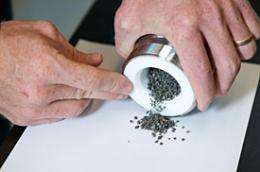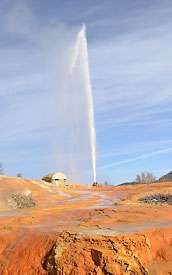Bringing carbon capture to a rock near you

For coal-rich countries like the United States, the concept of "clean coal" is too intriguing to ignore. With the implementation of carbon capture and sequestration, America's most abundant energy resource could continue supplying half of the nation's electricity while emitting less carbon dioxide.
But the research and technology underlying carbon storage is still maturing. Utilities have a good idea how to capture their CO2 emissions, but long-term storage in geologic formations still harbors many unknowns.
A better understanding of how CO2 can be stored underground will be crucial if industrial-scale carbon sequestration is to progress. Such research is thriving internationally, and Idaho National Laboratory's role in the carbon sequestration arena is growing both in the United States and abroad.
For example, INL researchers helped organize a recent International Energy Agency (IEA) Greenhouse Gas R&D Program conference focused on natural CO2 storage systems. Efforts to better understand such systems are key parts of INL's research, which includes studying natural CO2 discharge at Idaho's Soda Springs and collaboration on large-scale demonstration projects in the Northwest. Such work helps the research community learn how and why CO2 becomes trapped or escapes from geologic formations.
"We need to understand the spectrum of behavior so we can embark on industrial-scale demonstrations with some knowledge," said Travis McLing, a conference steering committee member and researcher with the Center for Advanced Energy Studies at INL. "We're trying to form a community to provide the justification to move forward, but we've only been studying CO2 for about a decade, so the field is pretty young."
International research focus

That's one reason the IEA group has been organizing biennial conferences to foster collaboration within the growing research community. Nearly 50 participants from more than 10 countries attended the last meeting in Germany last fall. The group's final report, released this spring, outlines research findings and areas needing more investigation.
Conference presentations focused on a range of topics including the challenges of monitoring CO2 leakage from natural systems, and how CO2 releases affect groundwater, flora and fauna.
In fact, the group highlighted the need for a database of "indicator" species of plants and microbes that thrive or wither in high-CO2 environments. Such a database could help spotlight leaky CO2 storage systems.
And conferees noted several other areas that also need more research. For example, they found gaps in understanding how CO2 may flow in aquifers, displace water, set metals and brine on the move, or impact seismicity. They want to better understand how CO2 behaves and can be contained far below the earth's surface.
And because both laboratory experiments and computer simulations are more accurate when informed by data from the field, they noted the need for more integration among these areas. That is exactly the sort of work happening at INL.
Idaho's natural laboratory
Lab researchers shared their findings via several conference presentations, including one highlighting INL's work at Soda Springs, Idaho — home to a large, naturally occurring CO2 storage system. McLing and his colleagues have been studying the system to see how leaking CO2 may impact communities, the environment and water chemistry.
Their main focus is chemical species that fluctuate with CO2 levels. McLing's team has identified distinctive chemical signatures that indicate when water has been in contact with underground CO2. Such signatures can spotlight CO2 leaks and help fine-tune laboratory setups to better reflect real-world conditions. Lab experiments that accurately mimic natural systems will do a better job of answering new questions that can't yet be tested in the field.
"We're trying to reproduce what we see in the field, coordinate lab observations with field observations," said McLing. "We can then use that laboratory system to answer other questions."
Such work is helping guide pilot projects, including two in the Northwest that are among the largest carbon storage demonstrations in the nation.
Big Sky Partnership
A site in eastern Washington will be the first in the U.S. to test whether a certain type of basalt can store 1,000 tons of CO2 for three years. A second site in Montana will receive 1 million tons per year for three years. Both projects are led by the Big Sky Carbon Sequestration Partnership — a collaboration among universities, national labs, private companies and state agencies. Their work aims to demonstrate the safety and viability of large-scale carbon storage.
And INL has played a major role. Lab researchers have been studying the Washington site's mafic basalt to help predict how much CO2 will migrate through it. Laboratory storage experiments spanning four to five months suggest the basalt will keep the CO2 trapped underground. The INL team also helped validate the CO2-tracking method that will be used at the pilot site during the demonstration.
Later this year, Battelle researchers based at Pacific Northwest National Laboratory intend to lead an effort to inject food-grade CO2 into the basalt formation near Wallula, Wash. The injection is expected to take a couple weeks. Partners will then spend the next several years tracking the CO2 within the basalt and assessing how quickly it is converted to carbonate minerals.
Meanwhile, INL will support the partnership’s research to characterize a sedimentary rock site in north central Montana called Kevin Dome. The researchers plan to inject 1 million tons of CO2 into the ground there each year for three years starting in 2013.
Although industrial-scale sequestration of CO2 from U.S. coal plants is still several years away, its development will rely on information from demonstration projects like these. INL researchers are excited to be part of such ambitious and long-term projects, which may even yield new findings the team can present at the next IEA Greenhouse Gas R&D meeting planned for July 2012.
"These opportunities allow INL to participate with an international research community that is continuing to flourish," McLing said.
Provided by INL














